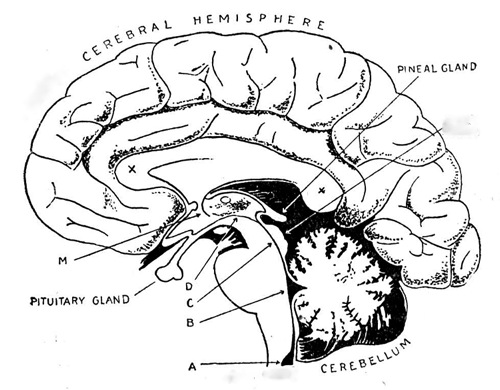|
Pineoblastoma
What Is It?A pineoblastoma is a rare malignant brain tumor which arises from the cells of the pineal gland which sits near the center of the head and brain. They are a form of primitive or undifferentiated tumor which displays pathology which is very abnormal, quickly growing and invasive.While other types of tumors are more common in the region of the pineal gland, such as a pineal germinoma, a pineoblastoma is one of the more malignant tumors found in this area. These high-grade tumors are related to and on a spectrum with more benign variants which are called pineocytoma, pinealocytoma or pinealoma (all different names for the same benign tumor).  What Types of Symptoms Are Typical?Because the pineal gland sits just above and behind the third ventricle and the cerebral aqueduct, fluid-filled spaces in the brain, an enlarging tumor in this region can compress the aqueduct, cutting off the normal flow of fluid within the brain. This can lead to what is known as hydrocephalus which results in enlargement of the ventricles and increased pressure in the head. This can lead to symptoms such as headache, nausea, vomiting and finally neurological deterioration as it becomes more severe.Other symptoms which can occur due to compression of the surrounding parts of the brain include a paralysis of upward gaze of the eyes and other eye and visual symptoms (due to compression of part of the brain stem called the superior colliculi), disturbances of gait and precocious puberty in children. How Is The Diagnosis Typically Made?Patients who present with symptoms suggestive of a brain tumor such as this will generally undergo a thorough neurological evaluation and examination. Often, a neuroimaging study such as a CT scan or MRI scan will be performed to detect the tumor. An MRI shows the most resolution of the tumor and surrounding normal structures.While most tumors in the region of the pineal gland can be identified readily on MRI, it is not always possible to tell what time of pineal tumor it is based solely on the imaging study. For example, it may be difficult to distinguish a pineoblastoma from a pineocytoma or a pineal germinoma. While some germinomas are treated solely based on the imaging findings, many tumors will require a surgical procedure to obtain tumor tissue which can be analyzed by a pathologist to make a definitive diagnosis. In the case of pineal region tumors, some patients will undergo blood and/or cerebrospinal fluid sampling so that they can be analyzed for two compounds, beta-HCG (human chorionic gonadotropin) and AFP (alpha-feto protein). These compounds can be produced by some types of germ cell tumors. Pineoblastoma however does not produce either. Additionally, the cerebrospinal fluid is sometime analyzed for cytology, meaning that it is analyzed for any tumor cells in the fluid. This can indicate spread of the tumor through the fluid to the spinal or other regions of the central nervous system. What Are Some Common Treatments?Treatment for pineoblastoma varies from patient to patient depending on specifics of each case such as age, tumor size and presenting symptoms. While other pineal tumors such as germinoma are very sensitive to radiation, surgical removal of pineoblastomas is often preferable. The aim of surgery can be to both obtain tumor tissue to analyze to make a definitive diagnosis and to remove as much of the tumor as possible. Various approaches to the pineal region can be used by neurosurgeons. In general, the procedures require a craniotomy (opening of the skull) in the posterior part of the head and is directed either above the cerebellum or between the occipital hemispheres to reach the pineal region.Some patients will undergo other treatments such as radiation treatments for residual tumor or chemotherapy, particular in these malignant tumors. Because the appropriate treatment varies considerably from patient to patient, each case should be evaluated and discussed with the patient's own treating physicians. from the Pineoblastoma page. Return to the Nervous System Diseases home page. Important Note: This site is not intended to offer medical advice. Every patient is different, and only your personal physician can help to counsel you about what is best for your situation. What we offer is general reference information about various disorders and treatments for your education. |
Inquire here about advertising on Nervous System Diseases.



